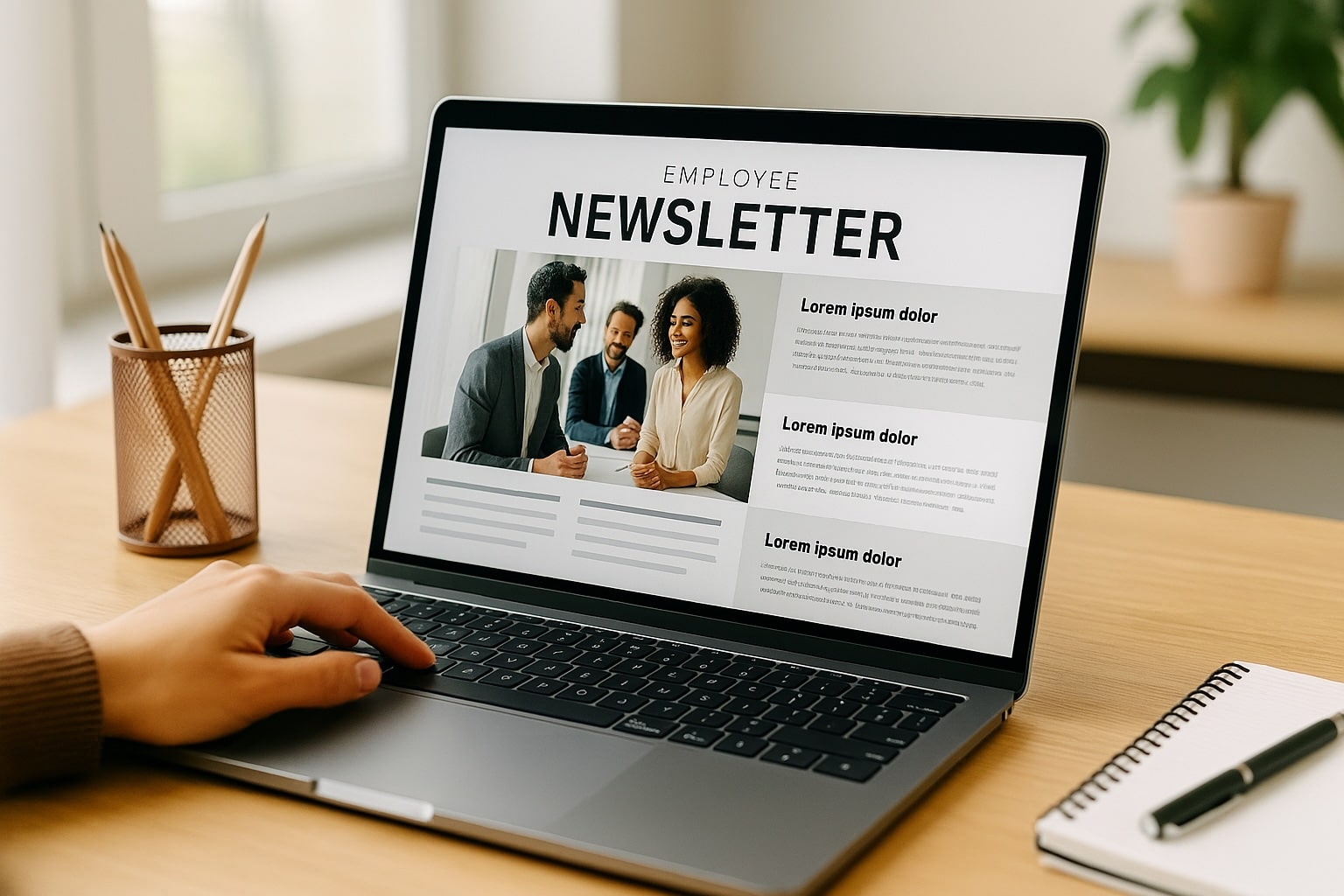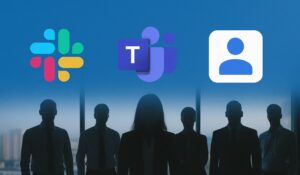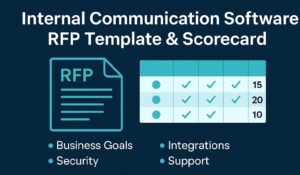Internal newsletter software helps organizations connect with employees, share updates, and build culture through consistent and engaging communication. Unlike external marketing email tools, these platforms are designed for internal audiences—focusing on ease of use, personalization, compliance, and integration with HR systems. In 2025, as hybrid and distributed workforces expand, newsletters remain one of the most effective ways to align teams and reinforce company culture. For a broader look at all communication solutions, see our guide on internal communication tools. You can also explore our internal communications email platform to streamline employee campaigns.
Key Features of the Best Internal Newsletter Software
- Drag-and-drop editors & templates: Build visually engaging emails without coding.
- Brand consistency: Maintain logos, fonts, and style across communications.
- Segmentation & personalization: Target messages by department, role, or location.
- Automation: Schedule recurring digests and trigger important updates automatically.
- Analytics & insights: Track open rates, clicks, read time, and engagement heatmaps.
- Integration: Connect with HRIS, Slack, Teams, intranet, or mobile apps.
- Deliverability at scale: Manage large employee lists reliably.
- Mobile optimization & accessibility: Ensure newsletters render across devices and meet accessibility standards.
- Interactivity: Add surveys, polls, comments, and multimedia content.
- Support & onboarding: Access to templates, guides, and customer success teams.
Best Internal Newsletter Software & Platforms (2025)
| Tool | Key Features | Best For | Pricing Range |
|---|---|---|---|
| HubEngage | Ease of use, HRIS integrations, multi-channel delivery (Inbox, SMS, Slack, Teams, Push Notifications), personalization, automation | SMBs to large enterprises | $$ |
| Cerkl Broadcast | Personalization, automation, analytics | Mid to large enterprises | $$–$$$ |
| Poppulo Harmony | Multi-channel (email, mobile, digital signage), compliance | Regulated industries | $$$ |
| PoliteMail | Outlook integration, analytics | Organizations using MS Outlook | $$ |
| ContactMonkey | Drag-and-drop builder, employee feedback tools | SMBs to mid-size | $$ |
| Staffbase Email | Branded templates, directory sync | Global enterprises | $$$ |
| Workshop | Simple builder, easy scheduling, analytics | Mid-size businesses | $$ |
| Connecteam | Interactive newsletters, mobile delivery | Deskless & frontline teams | $–$$ |
| Sociabble | Employee advocacy + newsletters | Large organizations | $$$ |
Tip: Choose based not only on features but also on adoption ease and integration with your existing tech stack. You can also explore our internal communications email platform for a unified approach.
Why Multi-Channel Matters for Employee Newsletter Software
Most often, people assume newsletters can only be delivered to inboxes, requiring every employee to have a corporate email address. But in industries with a mix of blue- and white-collar employees, that’s not always the case. Multi-channel delivery ensures 100% reach:
- Text messaging (SMS): Reaches frontline workers without email access. Read more about internal communication email.
- Slack or Teams notifications: In corporate environments, notifications inside chat tools boost visibility and engagement.
- One-click publishing: The same newsletter can be sent to multiple channels simultaneously, ensuring consistency without extra effort.
How to Choose the Best Internal Newsletter Platforms and Software
- Audit current communications: Identify gaps in how employees receive and engage with information.
- Set clear goals: Engagement, alignment, recognition, or reducing email overload.
- Evaluate integrations: Ensure it works with HR, collaboration, and intranet platforms.
- Consider scalability: Will the tool support your company as it grows?
- Budget wisely: Weigh licensing costs vs. ROI (engagement, time saved, fewer miscommunications).
- Pilot before rollout: Test with a single department or location.
- Get leadership buy-in: Communicate ROI and cultural impact to decision-makers (McKinsey research).
Best Practices for Employee Newsletter Platforms & Implementation
- Create content calendars to balance consistency with variety.
- Segment audiences to keep newsletters relevant. See practical internal communication email templates you can adapt.
- Keep it visual with images, infographics, and videos.
- Optimize subject lines & timing to boost open rates.
- Collect feedback through surveys or interactive blocks.
- Avoid pitfalls like overloading employees or neglecting mobile design. For inspiration, review employee spotlight newsletter ideas.
Automating Periodic Newsletters with AI
Modern platforms can now automate the entire newsletter creation process. AI analyzes what content is most relevant to employees, understands what they’ve already read or ignored, and then creates personalized summaries. Admins simply select the cadence—daily, weekly, bi-weekly, or monthly—and the AI delivers:
- Personalized newsletters tailored to each employee’s interests and role.
- Significant time savings for admins, removing hours of manual design and curation.
- Higher engagement across intranets, mobile apps, and communication portals, since employees receive content aligned with their needs.
Measuring Employee Newsletter Software Success
- Core metrics: Open rates, click-through, time spent reading.
- Engagement signals: Survey participation, comments, or feedback loops.
- Benchmarks: Typical internal newsletter open rates average 60–70% (higher than external email). Click-throughs often range between 15–25% (Ragan study).
- Iterate: Use A/B testing on subject lines, layouts, or content types. According to Gallup, higher engagement correlates directly with productivity and retention, making measurement critical.
Some organizations still rely on Outlook distribution lists or bulk emails to send newsletters. While this can work for basic needs, it often lacks analytics, personalization, and multi-channel delivery. Learn how to move beyond sending bulk email from Outlook or creating an Outlook email list to more advanced internal newsletter platforms.
Internal Newsletter Software Pricing & Value
- Small businesses: Low-cost tools ($–$$), usually $50–$300/month.
- Mid-size organizations: More automation and analytics, $500–$1,500/month.
- Enterprises: Advanced integrations, compliance, and multi-channel, often $2,000+/month.
- Total Cost of Ownership (TCO): Consider licensing, onboarding, training, design resources, and admin time. Platforms that integrate with existing systems can reduce TCO significantly.
Emerging Trends in Employee Newsletter Platforms
- AI personalization: Smart recommendations and automated content curation.
- Multi-channel delivery: Email plus push, Slack/Teams, and intranet feeds.
- Interactive newsletters: Live polls, embedded videos, and gamified content.
- Accessibility & localization: Support for global, multilingual teams.
- Trust & transparency: According to the Edelman Trust Barometer, employees trust internal channels more when information is consistent and transparent.
Case Study Example
A mid-size healthcare provider struggled with low engagement on their monthly email newsletters, averaging just 35% open rates. After switching to HubEngage’s multi-channel delivery and AI-automated newsletter creation, they:
- Achieved 72% open rates within 3 months.
- Saved 15+ admin hours per week previously spent on manual design.
- Boosted intranet traffic by 40% as employees clicked through from newsletters.
This example highlights how the right platform can drive measurable improvements in both efficiency and employee engagement.
Common Pitfalls to Avoid
- Sending newsletters too frequently or without valuable content.
- Ignoring segmentation, leading to irrelevant messages.
- Overly long, text-heavy newsletters without visuals.
- Neglecting mobile optimization or accessibility standards.
- Failing to review analytics and iterate. For inspiration, review company newsletter ideas.
Conclusion
Internal newsletter software is more than a distribution tool—it’s a driver of culture, engagement, and alignment. By choosing the right platform, setting clear goals, using AI automation, and following best practices, organizations can transform newsletters into a powerful communication channel employees actually want to read.
Ready to take the next step? Explore HubEngage’s internal communications email platform and see how easy it is to build, automate, and deliver engaging internal newsletters across every channel.
FAQs
What’s the difference between internal newsletter software and marketing email tools?
Internal tools focus on employee communication, compliance, and integration with HR systems—whereas marketing tools focus on customer engagement and lead generation.
How often should I send employee newsletters with internal newsletter software?
Weekly or bi-weekly works best for most organizations, but frequency should match culture and content availability.
What’s a good open rate for employee newsletter software campaigns?
Benchmarks average 60–70%, with click-through rates between 15–25%.
How much does the best internal newsletter software cost?
Costs vary widely: from $50/month for SMB-focused tools to $2,000+/month for enterprise platforms.
Can internal newsletter platforms integrate with Slack or Teams?
Yes, many platforms now allow newsletters to be repurposed across chat apps, intranets, SMS, and mobile apps for broader reach.













